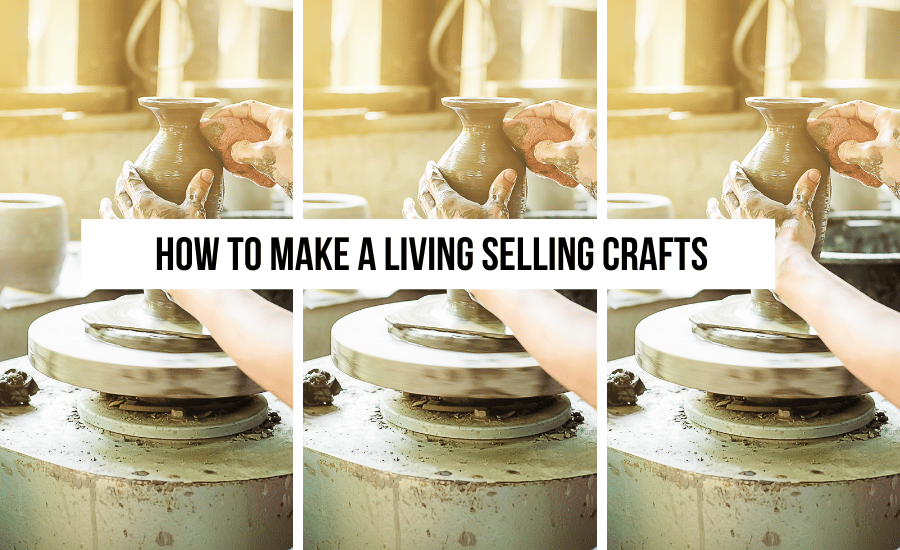Are you a creative person who loves making crafts? Do you dream of turning your passion into a profitable business? If so, then you’re in luck because selling crafts is a great way to make a living. With the rise of online marketplaces and social media platforms, it’s easier than ever to reach a wide audience and sell your handmade items. But where do you start? How do you turn your hobby into a successful business?
In this article, we’ll explore the ins and outs of selling crafts, from finding your niche to marketing your products. We’ll also share tips and tricks from successful craft sellers who have turned their passion into a full-time career. So, whether you’re a seasoned crafter or just starting out, read on to learn how to make a living selling crafts.

This blog post is all about how to make a living selling crafts.
Home > Etsy Biz > How To Make A Living Selling Crafts
DISCLOSURE: This is a sponsored post. Through my links, I may receive a commission if you decide to make purchases at no cost for yourself! Check out our disclaimer for more info on how it works.
The Advantages and Disadvantages of Selling Crafts
Selling crafts can be a great way to make a living, but it’s important to consider both the advantages and disadvantages before diving in. One of the biggest advantages of selling crafts is that it allows you to turn your passion into a business. If you love making crafts, then selling them can be a fulfilling and rewarding way to make a living. Additionally, selling crafts allows you to be your own boss and work on your own schedule. You can also work from home, which can save you money on rent and other expenses.
However, selling crafts also has its disadvantages. One of the biggest challenges is competition. With so many people selling crafts online and offline, it can be difficult to stand out from the crowd. Additionally, selling crafts requires a lot of time and effort. You’ll need to spend time making your products, marketing them, and managing your business. Finally, selling crafts can be unpredictable. Your sales may fluctuate from month to month, and it can be difficult to predict how much money you’ll make.
Despite these challenges, many people have found success selling crafts. The key is to find the right craft to sell and to approach your business with a strategic mindset.
Choosing the Right Craft to Sell
When it comes to selling crafts, one of the most important decisions you’ll make is choosing the right craft to sell. There are many factors to consider when making this decision, including your skills and interests, the market demand for your craft, and the competition in your niche.
First, consider your skills and interests. What crafts are you most passionate about? What skills do you have that can be translated into a craft business? If you’re a skilled knitter, for example, then selling knitwear may be a natural fit for you. Alternatively, if you love making jewelry, then selling handmade jewelry may be a better fit.
Next, consider the market demand for your craft. Is there a market for the type of crafts you want to sell? Are people willing to pay for them? One way to gauge market demand is to search for your craft on online marketplaces like Etsy. Look for how many products are available in your niche and what their prices are. This will give you an idea of the competition and what the market is willing to pay.
Finally, consider the competition in your niche. How many other people are selling the same type of craft? Are there any gaps in the market that you can fill? One way to stand out from the competition is to offer a unique product or to specialize in a specific niche. For example, instead of selling generic knitwear, you could specialize in eco-friendly knitwear made from recycled materials.
Learn How To Make A Living Selling Crafts On Etsy

Setting Up Your Craft Business
Once you’ve chosen the right craft to sell, it’s time to set up your craft business. There are several steps to this process, including registering your business, setting up a workspace, and sourcing materials.
First, you’ll need to register your business. Depending on where you live, you may need to register your business with the government or obtain a business license. Check with your local government to see what the requirements are in your area.
Next, you’ll need to set up a workspace. This could be a dedicated room in your home or a rented studio space. Make sure your workspace is well-lit, organized, and conducive to making your crafts. You’ll also need to invest in equipment and supplies, such as a sewing machine, tools, and materials.
Finally, you’ll need to source materials for your crafts. This could involve buying materials in bulk from suppliers or sourcing them locally. Look for high-quality materials that are affordable and eco-friendly.
Creating a Brand for Your Craft Business
Once you’ve set up your craft business, it’s time to create a brand for your business. Your brand is how you’ll differentiate yourself from the competition and build a loyal following.
First, choose a name for your business that is memorable and reflects your brand values. Next, create a logo and visual identity that represents your brand. This could involve hiring a graphic designer or using a logo maker tool.
Finally, develop a brand voice that is consistent across all of your marketing materials. Your brand voice should be authentic, relatable, and reflect your brand values. Use your brand voice to communicate with your audience on social media, your website, and in your product descriptions.
Pricing Your Crafts for Profit
One of the most challenging aspects of selling crafts is pricing your products for profit. You’ll need to consider the cost of materials, labor, and overhead, as well as the market demand for your products.
To price your crafts for profit, start by calculating the cost of materials and labor. Add up the cost of all the materials you use to make your product and calculate how much time it takes to make it. Then, multiply the total by your hourly rate to get your labor cost.
Next, add up your overhead costs, such as rent, utilities, and marketing expenses. Divide your overhead costs by the number of products you sell to get your overhead cost per unit.
Finally, add your labor cost, materials cost, and overhead cost per unit together to get your total cost per unit. Then, add a markup to this price to account for profit. The markup will depend on your niche and the market demand for your product.
Marketing Your Crafts Online and Offline
Marketing is key to the success of any craft business. To reach a wider audience and sell more products, you’ll need to invest time and effort into marketing your crafts both online and offline.
Online marketing can include social media marketing, email marketing, and paid advertising. Social media is a powerful tool for reaching a wider audience and building a following. Use platforms like Instagram, Facebook, and Pinterest to showcase your products, share behind-the-scenes glimpses of your process, and connect with your audience.
Email marketing is another effective way to reach your audience and keep them engaged. Collect email addresses from your customers and use email marketing software like Mailchimp or ConvertKit to send regular newsletters and promotions.
Paid advertising can also be effective, but it can be expensive. Consider using paid advertising on platforms like Facebook or Instagram to reach a wider audience.
Offline marketing can include craft shows, markets, and pop-up shops. These events allow you to showcase your products in person and connect with your audience face-to-face. Look for local events in your area and apply to participate.
Selling Your Crafts at Craft Shows and Markets
Craft shows and markets can be a great way to sell your products in person and connect with your audience. However, they require a lot of planning and preparation.
First, research local craft shows and markets in your area and apply to participate. Once you’ve been accepted, start preparing for the event. Create a booth display that showcases your products and represents your brand. Make sure your booth is well-lit, organized, and visually appealing.
Next, make sure you have enough inventory to sell. Estimate how many products you’ll need based on the size of the event and the expected turnout. Take into account the time it takes to make your products and order materials in advance.
Finally, promote the event on social media and to your email list. Invite your followers to come and visit your booth and share behind-the-scenes glimpses of your preparation process.
Managing Your Craft Business Finances
Managing your finances is an important aspect of running a successful craft business. You’ll need to keep track of your income and expenses, pay taxes, and budget for future growth.
To manage your finances effectively, consider using accounting software like QuickBooks or Xero. These tools allow you to track your income and expenses, create invoices, and generate financial reports.
You’ll also need to pay taxes on your income. Depending on where you live, you may need to pay state and federal income tax, sales tax, and self-employment tax. Consult with a tax professional to make sure you’re complying with all the necessary tax regulations.
Finally, budget for future growth. Set aside a portion of your profits for marketing, equipment upgrades, and expansion. This will allow you to grow your business over time and increase your profits.
Tips for Success in the Craft Business
Selling crafts can be a challenging and rewarding business. To succeed, it’s important to approach your business with a strategic mindset and to stay motivated and focused. Here are some tips for success in the craft business:
– Stay focused on your niche and specialize in a specific area
– Invest time and effort into marketing both online and offline
– Build a strong brand that represents your values and resonates with your audience
– Price your products for profit and stay up-to-date with market trends
– Stay organized and keep track of your finances
– Network with other craft sellers and learn from their experiences
– Stay motivated and don’t give up, even in the face of challenges
Conclusion
Selling crafts can be a fulfilling and profitable way to make a living. However, it requires a lot of hard work and dedication. By choosing the right craft to sell, setting up a strong brand, and investing time and effort into marketing, you can turn your passion into a successful business. Remember to stay motivated, stay organized, and stay focused on your goals. With persistence and determination, you can make a living selling crafts and turn your dreams into a reality.

+ show Comments
- Hide Comments
add a comment